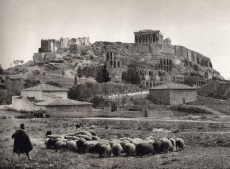
Athens might be a massive capital city today, but it wasn’t always like that. In fact, the capital was moved to Athens from its original Nafplio in 1834, for a variety of reasons. When it was moved there, Athens was basically a big village, with only a few thousand people in it. Let’s look to see why the government chose this city, despite its flaws, to be the figurehead for the new and independent Greek nation.
Most people say it was because of Athens’ classical history – the Acropolis dominates the landscape, reminding those who see it of the glory days of Greek civilisation. This intellectual and military force was admired by both the Greeks themselves and by the Western powers who ruled Greece at the time. It also meant the country could distance itself from its recent past under the Ottoman Empire, and make itself look superior. If you go to Athens today, all roads lead to the Acropolis, because the city was planned that way.
There were also not many alternatives. Athens was very small at the time, but most of the major Greek cities were still not included within the borders of the new Kingdom, because they were still under the Ottoman Empire – the War of Independence had not been successful in those regions. The only real competitor was Nafplio, which was already the capital. It had a reasonable economic and political structure already in place, but the government wanted to choose somewhere that could be a more “uniting” place, something that would make them more popular.
Athens was a good choice for this, because it fitted in with their ideology. “Bavarianism” was the idea that Greece had lost its civilisation, and only Westerners could teach them how to get it back again. The government of the time was from Bavaria, hence the name. Athens would be a symbol of unity for the new country, and it would make the government more popular. They hadn’t been very good at ruling so far, and perhaps they hoped choosing Athens would distract from this.
That’s because it fitted in with the “Megali Idea”, the idea that all Greek people should live under the guardianship of the Greek state. The idea was to move the capital to Athens, one of the historic centres of Greek culture, until the capital could eventually be moved to Constantinople, which was almost equivalent to Jerusalem in Greek eyes. King Otto himself apparently believed in this idea, despite the fact he was German and not Greek. Athens symbolised the greatness of Greek culture, and its potential for the future.
In a sense, the city of Athens was like a blank slate. There was a lot of land available that the government could build on, so they could plan and design the future city as they wished. They built the city in a neoclassical style, a popular style in Western Europe at the time, which had its roots in ancient Greek architecture. Thus, it symbolised the unity between Germany and Greece, and Athens was central to creating this vision for the future.
Image from: http://www.infokids.gr/2015/09/i-athina-san-simera-to-1834-egine-proteyoys/

0 Comment:
Be the first one to comment on this article.